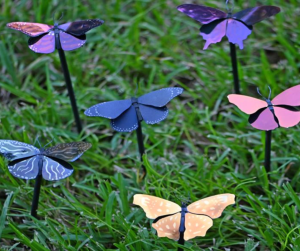Energy-Saving Paint Production Based on Nontoxic Colorless Materials
January 4, 2024
In the ever-evolving world of science and innovation, researchers around the globe are continually seeking inspiration from nature to develop groundbreaking technologies. One such fascinating endeavor involves biomimicry in the paint production process. Recently, we had the privilege of sitting down with a team of researchers who have delved into the world of biological species to create a sustainable and environmentally friendly alternative to traditional paints.
Inspiration from nature
The journey began with a scientist, Dr. Debashis Chanda, who had always been captivated by nature’s ability to produce colors in a vibrant and harmonious manner. In particular, his team looked to butterflies, marveling at the naturally vibrant hues they exhibit. The secret lies in structural protein molecules that serve as inherently non-absorptive materials. By organizing these molecules in a certain fashion, the researchers have been able to harness the power of nanophotonics to create angle- and polarization-independent colors which can be changed just by changing the structural arrangements of these molecules – a real breakthrough in the realm of paint production.
All previous attempts to create structural colors involve patterns/geometries, resonance of which are heavily dependent on angle of the incident light. However, the team sought to break free from this angular dependency and developed a process which arranges aluminum nanoparticles in a random organization that produces resonances that are both angle and polarization independent. In addition, the new technology requires only one base material while the different various colors are created from a change in dimension which is advantageous over normal paints that rely on a different pigment for each individual color, both inefficient and taxing on the environment.
How does this revolutionary paint work?
By studying the structure and dimensions of living creatures like butterflies, the researchers identified the optical resonances responsible for creating these vivid colors. Through careful analysis and replication of these biological functions, they developed a technology that produces paint with angle-independent structural colors.
The environmental benefits of this innovative paint are significant. Conventional paints contain toxins and heavy metals, which, even if undisclosed, find their way into nature and contribute to pollution. In contrast, the new paint is fully oxide and aluminum-based, providing a wide spectrum of colors without the environmental damage associated with traditional paint production.
Beyond its environmental advantages, sustainable paint also has economic implications. Surfaces coated with this paint remain cooler, reducing the need for air conditioning and lowering overall energy consumption. The challenge now lies in finding cost-effective methods for mass production, as the technology is still in the research and development phase. However, the market potential is promising, given its appeal to both environmentalists and art enthusiasts.
 Promise and cost of innovation
Promise and cost of innovation
The conversation shifted to the current model of college tech transfer offices and how it might be improved. The researchers emphasized the need for a model that doesn’t burden labs with extra expenses at the beginning. They proposed a collaborative partnership between universities and labs, where the university acts as a supportive partner rather than a financial liability.
Many labs struggle to meet the initial costs demanded by universities, hindering the progress of potentially groundbreaking technologies. The researchers advocated for a model where universities assist labs without imposing additional financial burdens, overseeing the scale-up process and prioritizing royalties and licenses over upfront fees. The current friction in the creation process, caused by universities seeking payments before labs have even generated revenue, highlights the need for a more collaborative and supportive approach.
In conclusion, the marriage of biomimicry and sustainable paint production holds great promise for the future. Not only does it offer a visually stunning and environmentally friendly alternative to traditional paints, but it also opens the door to economic savings through reduced energy consumption. As we continue to look to nature for inspiration, this innovative approach could revolutionize the way we think about color and its impact on our world.
This article was written by Jason Yan, a UNC student and IE Cleantech Summit intern.

